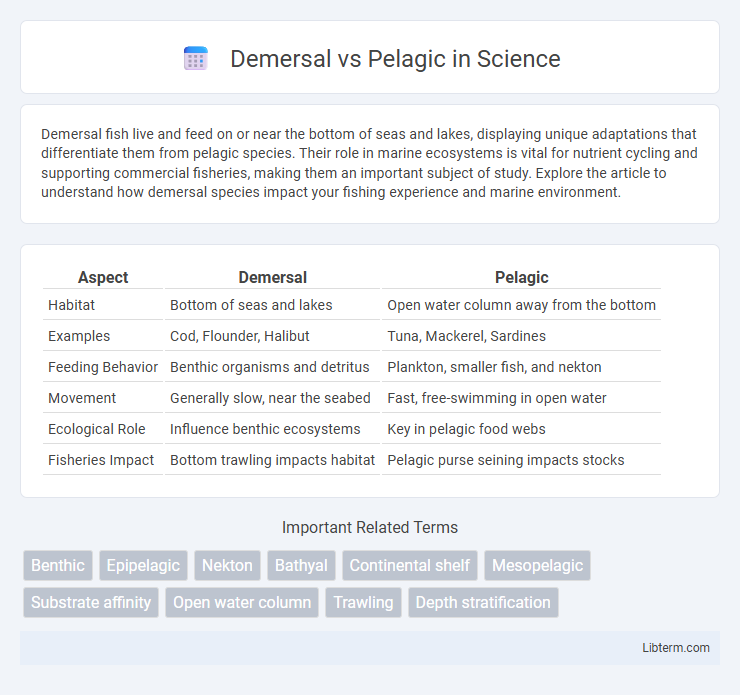Demersal fish live and feed on or near the bottom of seas and lakes, displaying unique adaptations that differentiate them from pelagic species. Their role in marine ecosystems is vital for nutrient cycling and supporting commercial fisheries, making them an important subject of study. Explore the article to understand how demersal species impact your fishing experience and marine environment.
Table of Comparison
| Aspect | Demersal | Pelagic |
|---|---|---|
| Habitat | Bottom of seas and lakes | Open water column away from the bottom |
| Examples | Cod, Flounder, Halibut | Tuna, Mackerel, Sardines |
| Feeding Behavior | Benthic organisms and detritus | Plankton, smaller fish, and nekton |
| Movement | Generally slow, near the seabed | Fast, free-swimming in open water |
| Ecological Role | Influence benthic ecosystems | Key in pelagic food webs |
| Fisheries Impact | Bottom trawling impacts habitat | Pelagic purse seining impacts stocks |
Introduction to Demersal and Pelagic Fish
Demersal fish live and feed on or near the bottom of seas or lakes, often exhibiting adaptations such as flattened bodies for resting on substrates. Pelagic fish inhabit the open water column away from the bottom, characterized by streamlined bodies suited for continuous swimming in mid to upper water layers. Both groups play critical roles in marine ecosystems, influencing trophic dynamics and commercial fisheries.
Key Differences Between Demersal and Pelagic Species
Demersal species inhabit the ocean floor or near the seabed, exhibiting adaptations like flattened bodies and downward-facing mouths for feeding on benthic organisms. Pelagic species dwell in the open water column, often possessing streamlined bodies and strong swimming capabilities to navigate vast, mid-water environments. Key differences include habitat preference, feeding behavior, and morphological traits that suit either bottom-dwelling or free-swimming lifestyles.
Habitats: Demersal vs Pelagic Zones
Demersal species inhabit the ocean floor and are closely associated with benthic environments, thriving in habitats like continental shelves, slopes, and deep-sea bottoms. Pelagic species, in contrast, occupy the water column away from the bottom, living in open ocean zones that range from the surface down to the mesopelagic depths. These distinct habitats influence the adaptations and behaviors of demersal and pelagic organisms, with demersals often relying on substrate for shelter and feeding, whereas pelagics depend on water column mobility and wide-ranging foraging strategies.
Physical Adaptations of Demersal and Pelagic Fish
Demersal fish exhibit physical adaptations such as flattened bodies, downward-facing mouths, and camouflaged coloration to blend with seabed environments and efficiently forage on or near the ocean floor. Pelagic fish have streamlined, fusiform bodies with strong, forked tails enabling fast, sustained swimming in open water and countershading coloration to avoid predators from above and below. These specialized adaptations in morphology and coloration reflect their distinct ecological niches within marine ecosystems.
Feeding Behaviors and Diets Compared
Demersal fish primarily feed on benthic invertebrates, crustaceans, and small fish found near or on the sea floor, relying on sensory adaptations to detect prey in low-light environments. Pelagic fish, in contrast, consume a diet rich in plankton, smaller pelagic fish, and nektonic organisms, often utilizing visual hunting strategies in open water columns. These dietary differences illustrate niche specialization, where demersal species exploit bottom resources while pelagic species capitalize on mid-water prey abundance.
Reproduction Strategies: Demersal vs Pelagic
Demersal species exhibit reproductive strategies characterized by laying eggs on or near the seabed, often attaching them to substrates to enhance survival and protect against predation. Pelagic species typically release free-floating eggs and sperm into the open water, relying on high fecundity and dispersal for reproductive success. These contrasting strategies reflect adaptations to distinct environmental conditions, influencing larval development and population dynamics in marine ecosystems.
Importance in Marine Ecosystems
Demersal fish, living near or on the seabed, play a crucial role in benthic ecosystems by controlling invertebrate populations and recycling nutrients, which supports overall marine biodiversity. Pelagic fish inhabit the open water column and contribute significantly to energy transfer between trophic levels by serving as prey for larger predators and helping regulate plankton populations. Both groups are essential for maintaining balanced marine food webs and supporting sustainable fisheries that millions of people rely on for food and economic stability.
Commercial Fisheries: Demersal vs Pelagic Harvesting
Demersal fishing targets species dwelling near or on the seabed, such as cod, haddock, and flatfish, using methods like bottom trawling and longlining that can impact benthic habitats. Pelagic fishing focuses on species inhabiting the water column, including mackerel, herring, and tuna, employing techniques like purse seining and midwater trawling to capture large schools. Commercial harvesting strategies differ as demersal fisheries often require selective gear to reduce bycatch and habitat damage, while pelagic fisheries emphasize efficient, large-scale capture of highly migratory species.
Conservation Challenges and Threats
Demersal fish, living near the seabed, face threats from bottom trawling, habitat destruction, and sediment disturbance, leading to declines in biodiversity and ecosystem health. Pelagic species, inhabiting the open water column, are vulnerable to overfishing, bycatch, and changes in ocean temperature and acidity caused by climate change. Both groups require targeted conservation strategies to address habitat degradation, fishing pressures, and environmental shifts impacting marine food webs and population stability.
Summary: Choosing Between Demersal and Pelagic Fish
Selecting between demersal and pelagic fish depends on habitat preference and culinary use; demersal fish dwell near the seabed with firm texture and rich flavor suited for grilling or frying, while pelagic fish inhabit open water, offering lighter, oilier flesh ideal for smoking or smoking. Nutritional profiles differ as demersal species often contain higher fat content and omega-3 levels, whereas pelagic species provide lean protein with essential vitamins. Fishing techniques also vary, with bottom trawling targeting demersal fish and midwater nets used for pelagic fish, impacting sustainability and bycatch rates.
Demersal Infographic

 libterm.com
libterm.com